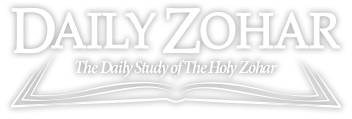Daily Zohar # 4488 – Tetzaveh – Blessed, starts harsh, and ends soft
Daily Zohar 4488

Hebrew translation:
142. בֹּא וּרְאֵה מַה בֵּין דִּין עֶלְיוֹן לְדִין זֶה. דִּין עֶלְיוֹן תְּחִלָּתוֹ וְסוֹפוֹ קָשֶׁה, וְאֵין מִי שֶׁיַּעֲמֹד בּוֹ, וְכָל מַה שֶּׁהוֹלֵךְ מִתְחַזֵּק, וּלְבַסּוֹף שֶׁשּׁוֹרֶה, לֹא זָז מִשָּׁם עַד שֶׁמְּכַלֶּה וּמַכְרִית הַכֹּל שֶׁלֹּא נִשְׁאָר כְּלוּם. אֲבָל דִּין אַחֵר שֶׁלְּמַטָּה, רֵאשִׁית קָשָׁה, וְכָל מַה שֶּׁהוֹלֵךְ – נֶחֱלָשׁ, עַד שֶׁמֵּאִיר פָּנִים, כְּדֻגְמַת (זֶה דִין שֶׁל הַנְּקֵבָה) הַנְּקֵבָה שֶׁנֶּחֱלָשׁ כֹּחָהּ.
.
Zohar Tetzaveh
Continued from previous DZ
#141
Psalm 113:2
“יְהִי שֵׁם יְהוָה מְבֹרָךְ מֵעַתָּה וְעַד עוֹלָם.”
“May the name of YHVH be blessed from now and forever.”
What does “blessed” mean? One of our friends knew one secret that was shown to him in a dream. His name was Rabbi Yitzhak Kaftora. He asked what is “blessed.” It is that its beginning is hard, and its end is soft. For “blessed” (מבורך) are the letters Mem-Bet (מ” ב) and Resh-Kaf (ר” ך). Mem-Bet (מ” ב) is hard. It signifies strict judgment, similar to Rosh Hashanah, which is Mem-Bet, because with Mem-Bet (42) letters, the world was created, that is, with the thirty-two paths of wisdom (ל” ב אלהים) and the ten utterances, which are Mem-Bet (42). Likewise, there are Mem-Bet (42) letters from the second word of Genesis’ ב’ until the letter Bet’ ב’ of “ובוהו,” and therefore it was created with judgment (דין). And afterward, Resh-Kaf (ר” ך), which is soft. Therefore, we learn that all beginnings are harsh, and their end is soft. On Rosh Hashanah, Mem-Bet is strict judgment, and Shemini Atzeret is soft with joy.
Lesson;
The strict process of Creation is called judgment, ‘דין’ represented by the first 42 (6×7) letters of the Torah. Rosh Hashanah is the day of judgment, and the eighth day, after the seven days of Sukkot, is the final step of the judgment, soft, in the process that started on Rosh Hashanah.
#142
What is the difference between the Upper Judgment, namely the Left line from Binah, which is the aspect Isaac, which is the light of the male, and the judgment of the Nukva? The Upper Judgment in the male illuminates from above to below; its beginning and end are hard, and no one can withstand those judgments. It grows stronger on its way down, and after it begins, it does not leave until it consumes and finishes everything, and nothing remains. But the other judgment from below, namely in Malchut, which is the light of the Nukva illuminating from below to above, the beginning is hard, namely on Rosh Hashanah, and everything that goes and spreads weakens until it shines on Shemini Atzeret. This is similar to a female whose strength is weak.
{||}

 Previous: Tetzaveh
Previous: Tetzaveh
